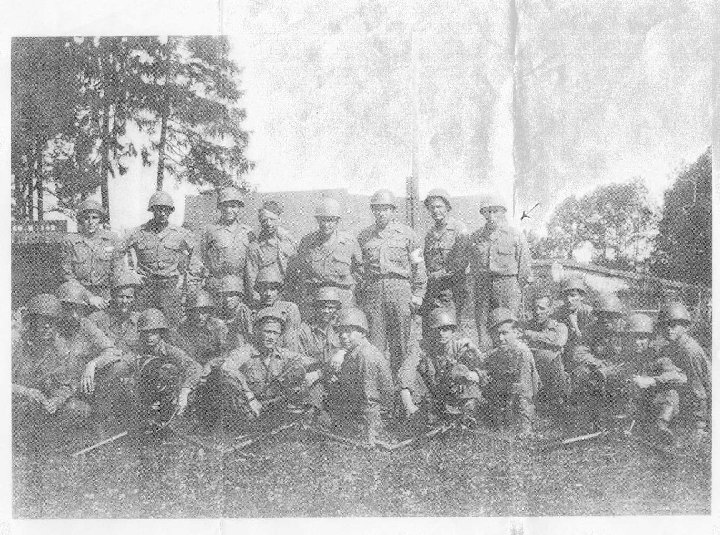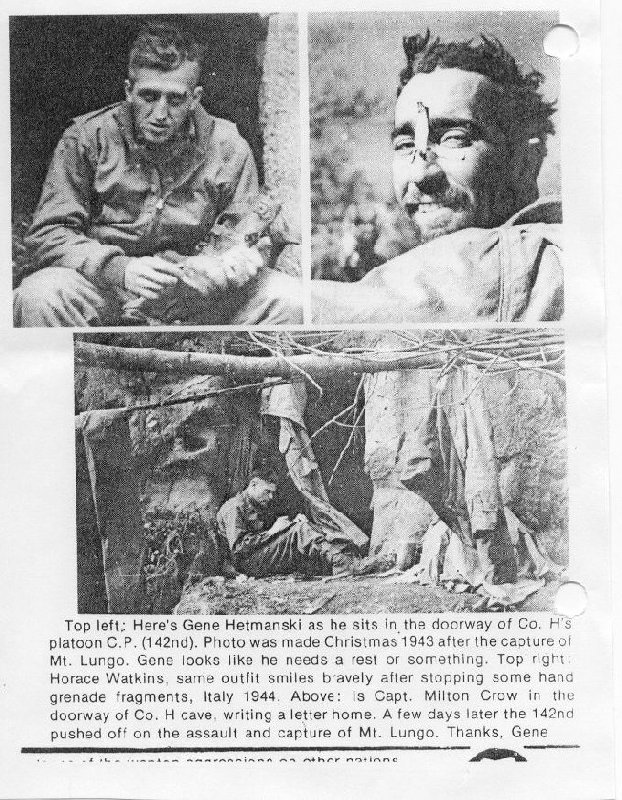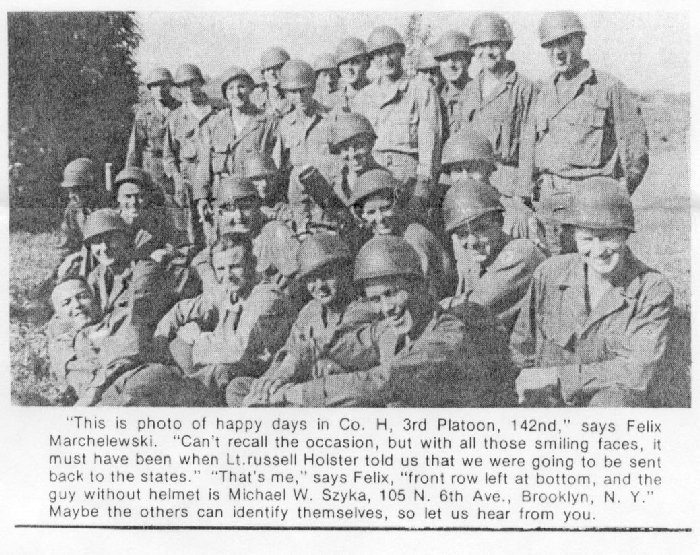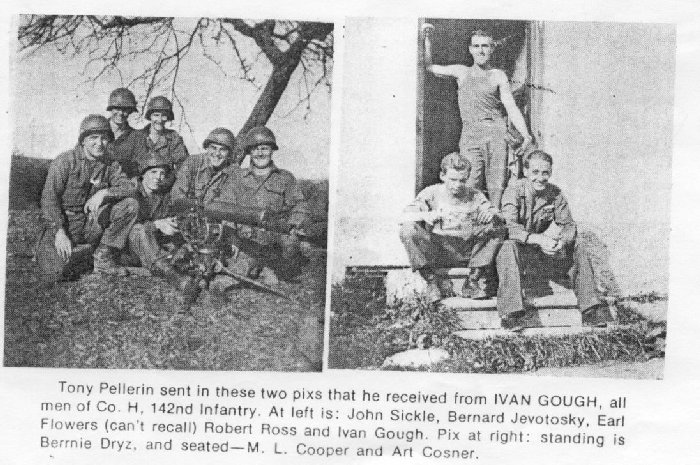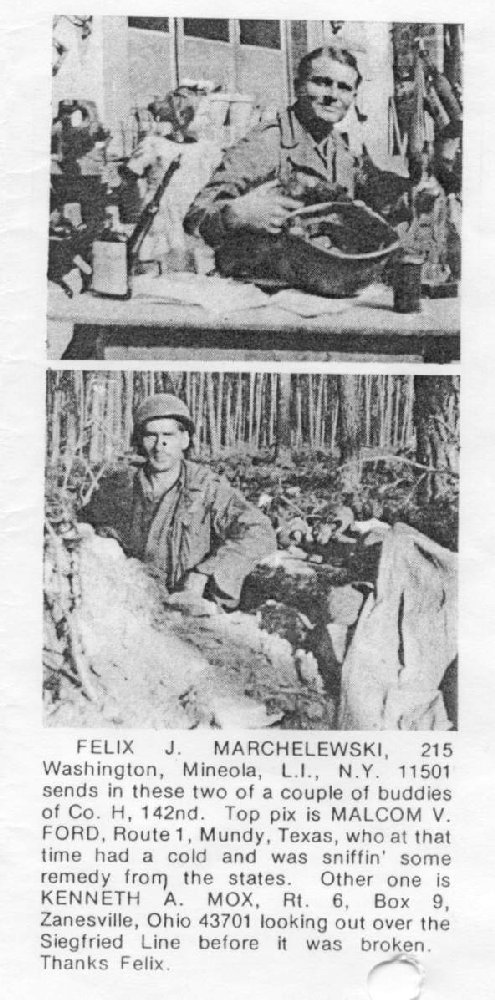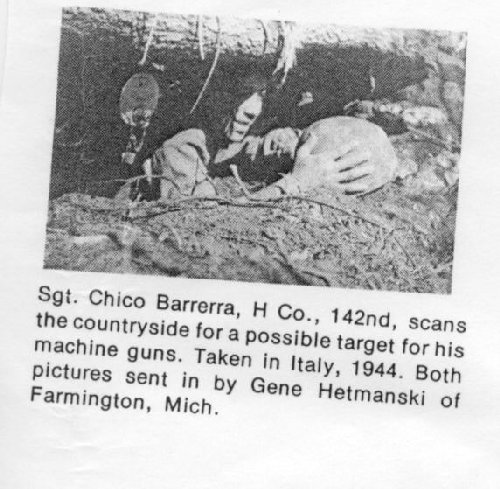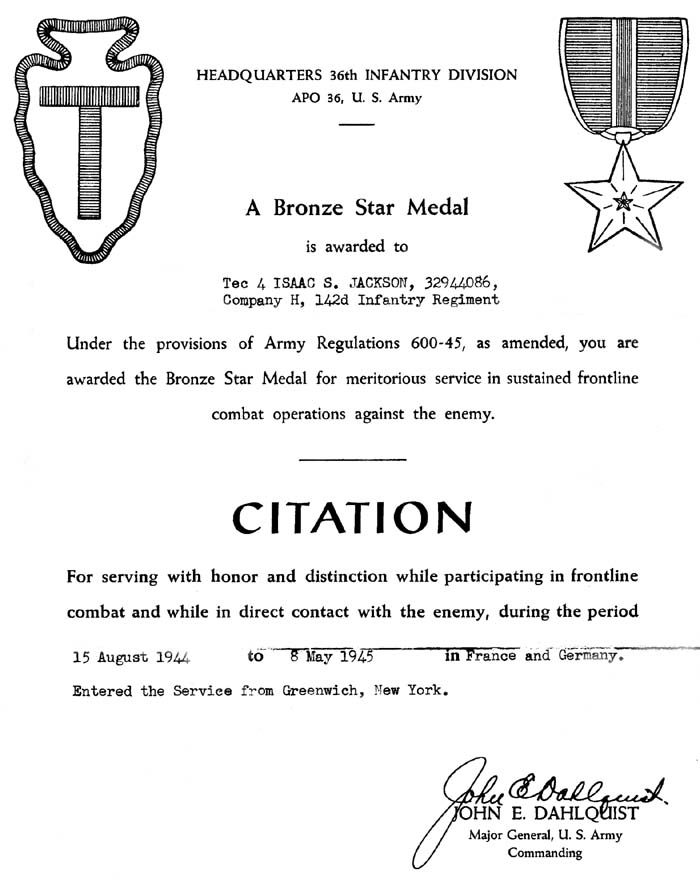I Was There
by
Isaac S. Jackson
1919 - 2002
Introduction
The World War II has reached its 50th Anniversary. Personally, I had never
forgotten my experiences and at the
same time I didn’t attempt to tell them.
I read several books and watched the T.V. shows and gradually decided that
my own experience was worth telling. At the same time several of my
children and grandchildren were interested in my stories.
After basic training I was sent to join the 36th Infantry Division.
The 36th was already in
action in Italy. I was with the 36th until the war ended.
An infantry division consists of 15,000 men. My stories are about
the things that I was a part of.
The 36th division had 27, 345 casualties in five campaigns. I am
thankful that I can still tell my experiences.

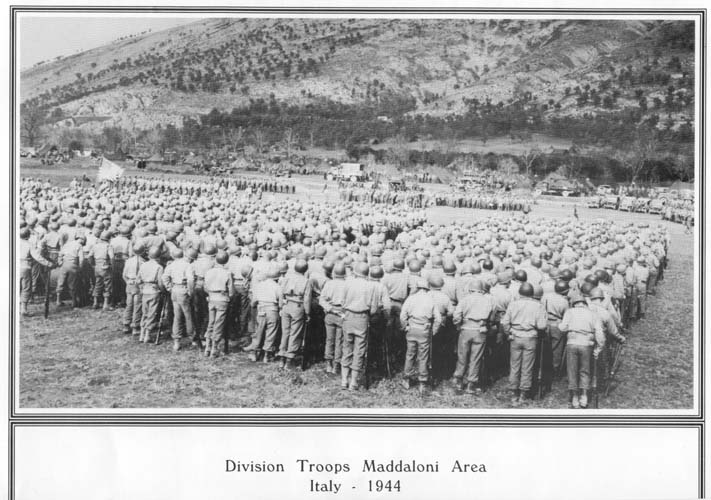
Chapter One
I was there.
Where?
World War II.
Jean and I were living in Milford, Connecticut. I was employed
in an aircraft company named
Vaught-Sirkorsky and at the same time Egore Sikorsky
was developing the first successful helicopter.
Jean and I would make a trip home when we could get a weekend and
we would travel back on Sunday. We had a car radio
and got the shocking news that Japan had attacked Pearl Harbor.
It wasn’t too long after this that our first son David was born, July 20, 1943.
I had been registered for the draft in Greenwich. They had given me a period
of time. We decided that we would move back to Greenwich. Jean and David
moved in with Grandpa and Grandma Stevens. I moved in with Uncle Sam.
Our military training begins.
A bus was waiting on Main Street between the White Swan Hotel and the First
National Bank. The draftees were organized in a group and herded onto the bus.
The streets were lined with family members and friends. There were cheers and
flags waving and good-by tears.
We had no idea where we might be going. Most of the trip was by train. Our
train trip started in Albany and changed in New Jersey. From New Jersey the
train took a couple of days to get us to our destination. It was Camp Wheeler
near Macon, Georgia. Basic training was the primary and only training that a
foot soldier needed. It wasn’t long before we realized that we were being
trained to replace soldiers that had been lost in action. Our training period
would last seventeen weeks.
It was during this training period that a message for me arrived. Our top
sergeant called me and told me to report to the Chaplain. I did this and found
out that my brother Jack had been killed in action in Italy. He was in the
34th Infantry Division. At the time of his death there were four Jackson
brothers in the service. William was an Air Force radio sergeant. George
(Jordy) was in the 5th Infantry Division. I was training in Camp Wheeler.
Our training was fast coming to an end. At the end we soldiers would be given
a leave of three weeks with an on-route visit home. We were to report to
Norfolk, Virginia. The army is very particular that the soldiers will look
their very best when they take that trip. They inspect each soldier before
he is allowed to go.
They even went so far as having a dry run. The group of soldiers were gathered
on one of the training fields. There was a stage in front of them with a place
for the judging officer and his secretary to sit. The judging officer came
forward and explained how important it was that each soldier would look perfect.
He also explained that his decision would be final when the inspection was
made. He called for the first man.
That man started across the stage and tripped just before he reached the
officer. He jumped to his feet and saluted the officer and stood at attention
(It became apparent to the entire group that the soldier that was first was
also a clown). His cap was too small and it stood on top of his hair; his
dress jacket was four times too large and the sleeves covered his hands; his
pants were too short and they showed his bare legs above his boots which also
curled up at the toes.
The officer in charge made an inspection all the way around to his starting
point. He said, “Soldier, have you lost a lot of weight?” Answer: “Yes sir,
I need a whole new uniform. I fall down every time I have to march.”
The officer, his assistant, and soldier faced the company of soldiers. The
officer stood at attention and saluted the audience. The entire company
cheered, whistled, clapped their hands.
It wasn’t long until an inspection was called for the entire company. One
by one, paraded through the inspection. I had lost about fifteen pounds.
They issued me a new jacket.
Our seventeen weeks of basic training ended and we started home. The onroute
travel allowed me a little over a week at home. Our home was Grandma and
Grandpa Stevens, wife Jean, and son David S. Jackson. I was happy that we
would be together with family and friends. Little did I know that I would be
away from my family for the entire war.
Chapter Two
My visit at home ended and my trip to Norfolk, VA began. Grandpa Stevens
and my wife Jean drove me down to Albany. We said our goodbyes. I went
searching for my train to Norfolk. I was happy to learn that information
people were happy to take me there. When we arrived at Norfolk, there were
soldiers waiting to take me and others to the ship that was waiting.
We were informed that this ship was designed to be a troop carrier.
It would travel faster than all ships. It was capable of making quicker turns
than any others, and this would be its first trip.
Early the next morning, our ship started south along the coast. When the
time was right, they made a turn into the south Atlantic. For the next
several days, they zigzagged and made the speed faster.
We arrived at our port and were completely amazed to find out that it was:
Casablanca N.W. Morocco. All of the soldiers were amazed to find themselves in
Casablanca.
We were taken to barracks and settled in. They kept us busy for several days
and then ordered us to pack our duffel bags.
We were taken to railroad yards and found out that we would be traveling by
railroad. The railroad cars were strung out as far as you could see. The
boxcars were the kind that were named 40 or 8. It means 40 men or 8 donkeys.
To make it more interesting, each man carried a duffel bag and his backpack.
In the center of the boxcar, a 50 gallon canvas bag was suspended from the
ceiling. There was a little valve at the lower side of the bag which could be
pushed to get water. Every once in a while someone would bump the valve.
This meant the floor of the car was always wet. You were expected to sleep on
the floor.
The trip was from Casablanca to Oran. It took several days, mostly through
the desert. It was hot in the days and cold at night. When we came to a
depot, everybody piled out of the cars and lined up to use the toilets. That
was an experience. The top of their toilet bowls was horizontal to the floor
and it funneled to the center. There wasn’t any water. There wasn’t any
paper. It was almost impossible for everyone to lie down at night. We didn’t
have any choice.
Our train ride from Casablanca brought us right to the boat docks in Oran.
We were guided to an area close to the ship that we would be boarding. It
was a British ship which apparently was outfitted for transporting troops.
We made our trip from Oran to the harbor at Naples, Italy.
Chapter Three
At this point, I would like to explain that the 36th Infantry out of Texas had
already made an amphibious invasion at Salerno, Italy. The Germans were ready
and waiting. Slowly but surely our troops were able to establish themselves.
Supplies had to be brought in from the ships. Weeks of combat made many
casualties. The constant pressure finally overcame the Germans. They
withdrew towards the north and finally set up defense lines north of Naples.
The 36th division was withdrawn for rest and the rebuilding of the losses.
This is when we replacements were to join the 36th division.
I joined the 36th division as a replacement. I have seen a picture of all the
replacements as a group. They were at attention and they would fill a
football field. This group was divided through out the division. I got
appointed to “H” Co., 142 - INF.
A company consisted of four machine gun squads and four mortar squads. Each
soldier, when fully armed, carried a load of 70 pounds. When I look back it
is hard to believe that we were able to go the distances that we were expected
to do. They gave us a ten-minute break each hour.
When the Germans retreated they set up another line of resistance farter north
in the mountainous area. This left the area from Salerno to the new line of
resistance under the control of the 36th and other American troops.
Another interesting situation was that Mt. Vesuvius was erupting. Huge clouds
of smoke spread, and large areas were covered with 2” to 4” of black ashes.
The Germans set up a line which went from the Mediterranean all the way across
to the opposite side of the “boot.” Italy has a lot of mountains which run
through the center from the top down to the city of Naples.
In years past the Abbey Casino was built in the center which 360 degrees
vision. The American troops were at a disadvantage. In the beginning of the
attack by the 34th division, the Rapido River had to be crossed and the 34th
division was not able to cross. (I had a brother John Jackson killed in this
battle).
Up until now we hadn’t included the Casino in our attack. The price we paid
was too high. US Air Force bombers were called in. They bombed until it was
just a pile of rocks.
At about this time another attack was made to flank our battle against the
German line. It was an amphibious landing Anzio beachhead.
This was a constant battle for those who made the landing. They had to fight
off the German attacks and stand firm.
Chapter Four
About the time Anzio beachhead was made, our company H Co. 142 Infantry, was
called back for amphibious training. This amounted to how to get yourself and
your equipment onto the boat, what a boat ride consists of, and finally how to
get off the boat. I know this sounds kind of funny. It wasn’t funny if
someone is shooting at you. We had a couple more days of training. The next
time that we got on the boat we knew that we were on our way.
I don’t know what time it was but I do know that it was late in the day. I
couldn’t hear any firing. We pulled up close to a dock, one by one we walked
up the dock and walked to an area that was waiting for us. We were on Anzio
Beachhead.
By now it was dark, however the sky was clear. Our group moved out on a dirt
road in a northerly direction. We seemed to be in no man’s land. Marching at
night with a load on your back is a tedious affair. After a while you become
hypnotized. I have seen men wander right off the line. A poke in the back
brings him back in line.
Another way to get your attention is to have a long range cannon fire right
over the road that you are traveling on. If one isn’t enough, how about four
cannons? My guess is that they were a half mile away. By the way, these
cannons were on our side. Our officers sent the word down to take a break.
It was a good place to stay awake.
We continued until daybreak and stopped again. This time we stayed longer.
We were hungry and tired. When we started again I noticed that we were coming
into a hilly country side. It was during this part of our advance that we
came to a Medical collection station. I for my entire life have never
forgotten the sight of a line of dead American soldiers. They were carefully
lined up and covered with a tarp, to be returned to headquarters.
We decided that our company had been marching for 33 hours. We just dropped
everything and went to sleep. Guards were posted and changed as the night
went on.
Our supply jeeps followed us and we replenished our food and filled our water
cans. They also had enough candy bars and cigarettes to go around.
We were informed that the Germans were using a road as an escape route. The
German troops were being forced out of their holdings, pressured by one our
divisions from the Rapido River area.
We were to climb a hilly section to position ourselves and wait. It took us
about two hours. The officers gave us locations to set up the machine guns.
We had been trained to locate the squads in spots where we could support the
gunner. I carried two metal boxes of ammunition. The box had bullets mounted
on a belt which was fed into the side of the gun. The gunner pulled back a
lever to load it and a trigger to start firing. This could be done in a
matter of seconds. There were four men carrying ammunition.
At the same time 80 millimeter mortars were positioned much the same as we
did for the machine guns.
Chapter Five
I don’t know how many machine guns and mortars were set up. All I know we
were sitting on top of a hill - waiting. Somebody said we better start
digging slit trenches. A slit trench was long enough and wide enough and
deep enough to get below the surface. Everybody carried small trench shovels.
During training we were advised to have a “buddy” close by. I had a buddy
named Vito. Vito was about my age. We were quiet, it seemed like the calm
before the storm.
Riflemen were on stand by. Their job was to advance toward the area where the
Germans had been attacked.
When the action started, little did I know that I would survive. When the enemy
came into view, we waited for our orders to fire. When the orders came, all
hell broke loose.
The enemy soldiers were scattering and finding cover. The guns and the mortars
were firing full blast.
Vito and I had made slit trenches but in order to get below the surface we also
had to lay our packs, water cans, and ammunition (for the machine gun). Also,
each of us carried a rifle and a helmet.
After a period of time we heard the whish-whish sound of mortar shells coming in
our direction. We were still firing. Now we had return fire. Their accuracy
improved, shells were coming down on all sides. Finally, we heard rifle fire
from our riflemen. It continued until it gradually tapered down to nothing.
I called, “Vito, you alright?” No answer.
I called again, “Vito, you alright?” No answer.
I went over to him and took hold of his shoulder. He looked up and said,
“Is it over?” When I started picking up my gear, I discovered that my back
pack was shattered, my water canteen had the top blown off, the stock on my
rifle was shattered, and one of my ammunition cans was dented.
It took quite some time to reorganize our company and prepare to move on.
Within a half a day we were moving. Anzio Beachhead is about fifty miles south
of Rome.
The Abbey Casino located in the center of Italy gave German soldiers
observation all across the “boot.” Our forces were hard hit during their
northern thrust.
The bombing of the Casino and the Anzio Beach landing drove the German
soldiers to retreat. Our troops on both sides of the mountain began to move
in a northward direction up the “boot.” The retreating Germans set up
blockades in several places to delay the advance of our troops. Several days
passed before we could reach Rome. Snipers were usually in buildings or wooded
areas.
We had been traveling in the US Army 21 ton trucks. We reached the outskirts of
Rome and proceeded on the main streets and highways. We passed the historic
Coliseum and the Vatican City. Sniper fire continued.
Our trucks continued through Rome and on in a northerly direction for about
five miles. We pulled into a large open field and set up a bivouac for a rest.
About the time we were all settled four American fighter planes buzzed our camp.
Thank goodness they didn’t start firing. We dove for cover in all directions.
They didn’t expect to see an American camp.
For several days our troops were allowed to visit Rome. I visited the Vatican,
the Coliseum, and several Roman buildings.
While we were still there, news reached us that on June 6, 1944, D-Day had
begun. This was great news for the divisions in Italy. The German divisions
were moving back towards northern Italy. Northern Italy borders on France,
Switzerland, and Austria. Germany controlled those countries.
The American divisions started moving north (5th Army). The retreating Germans
did everything they could to slow up the progress of the Americans. Bridges
were blown up, roads were mined, and snipers were left in buildings. Thirty
miles to the northwest the 36th division captured Civitaveschia about 30 to 35
miles from Rome. Things moved so fast that supplies had difficultly keeping up.
Our 36th division went on and on through many small villages. The Italian
people lined the streets and cheered and waved Italian flags. We appreciated
the welcome. After about 150 miles, the 36th division reached the city of Pisa,
located on the northwestern coast. At this point, the 36th division was
relieved and taken back to a rest area near Rome. The squad that I was part of
remained intact and we welcomed the rest. After a week, we were moved back to
(of all places) “Salerno.” Once again, we were given amphibious training -
this time on larger ships and more open waters.
Chapter Six
During the period of this amphibious training, all of the soldiers were
projecting what the future would be. As it turned out, just about all were
correct. When the troops were transported to a staging area, there was no
doubt. The Southern France “D Day” was August 15, 1944. The time was 0800.
The landing forces were the 141st Infantry, 142nd Infantry, and the 143rd
Infantry. Three landing locations determined:
the 141st was to land at the “Blue” beach;
the 142nd was to land at the “Red” beach; and
the 143rd was to land at the “Green” beach.
Each of the three regiments had been loaded into landing crafts. Several
crafts were needed for each regiment. Each regiment formed a large circle.
While all of this was going on, several large navy ships were firing cannons
over the top of our circling regiments, to bombard our three landing areas.
All of the men in the landing crafts were standing up, ready to charge down the
ramp when it was dropped. The return fire from the enemy was rather light.
The landing areas were difficult to see. The artillery from the ships built up
a huge explosion of smoke and dust. The 141st was to go to the right side. The
143rd would attack the left side forming a flanking attack. I was in the
142nd which was to attack the center. As we approached land, we noticed that
the beaches were lined with obstructions. Headquarters ordered us to change
our direction more to the right and go in. This was a good move. We landed and
moved into the area in front of us. In addition, Canadian and British troops
along with French Commandos swept in from the Mediterranean Sea.
Our troops were able to push inland ten miles on the first day (Saturday
8/15/44). Within a month, Allied troops overcoming German resistance, had
pushed nearly 500 miles inland. One third of France was liberated by
September 11, 1944. Four million tons of material was supplied.
As I recall it from our 142nd regiment, we advanced miles inland and had time to
“dig in” and wait for the German troops. The other two regiments did the same.
Chapter Seven
It was several days before the German 19th Army faced off with the 36th division.
They were up against a well-established American Seventh Army. The escape
routes were blocked. Several days of fighting left the 19th German Army
completely defeated.
The terrain in that area was quite flat. One could look south across the area
and see blown out railroad tracks, also bridges across small streams, military
equipment, farm buildings, wandering horses and cows that managed to survive.
The fields must have had crops of wheat or other kinds of grain. This had
burned and left black ashes.
The battle had ended with 11,00 German casualties, destruction of 4,000
vehicles, 1,500 horses, and all of the artillery of two complete divisions.
(Note: this information has been taken from “The Fighting 36th” Quarterly,
published and available to veterans of the 36th division).
The 36th division moved on to the north towards Lyon. They found that all
bridges were destroyed but one. The 111th Engineer Battalion entered the city
to restore access.
The 36th continued in a northerly direction leading the 7th Army toward the
Vosges Mountains. Fall weather was making it cooler.
Chapter Eight
The First Battalion of the 141st Regiment had taken position on the high
ground overlooking an area that they intended to take. The Germans maneuvered
themselves into a complete circle around the 141st and they became the “Lost
Battalion.” The lost soldiers dug foxholes and protected themselves as much
as they could. They had no supply of food, ammunition, water, or whatever they
needed. There was some firing between them and the Germans. All the Germans
had to do was play the waiting game. The 142nd Regiment was sent up to face
the German positions. I’m sure that a large number of the 142nd troops and
others were brought in. H Company had been positioned in a spot to cover a
given area. They were told to be ready for orders. We were told to be
completely hidden. I looked down the trail and saw this group of soldiers
headed up toward us. I felt somewhat relieved. They were being led by an
American sergeant and all of them were in American uniforms. I thought it was
strange - they were all little guys in American uniforms just like my own.
When they got up close I said, “Boy, am I glad to see you guys.” None of them
answered but all of them put big smiles on and marched on. I really was glad
to see them. The 442nd Japanese American regiment continued on, associated with
our 36th division for quite a long time.
Keep in mind that the Fighting 36th has all kinds of support: transportation
of food, ammunition, medical supplies, tanks, engineering crews, artillery as
part of our division, available Air Force and US Navy for amphibious landings
and more I am sure.
It wasn’t long before the American troops were moving into Germany from our
location. The first encounter was with the Seigfried line. The Seigfried
line was a series of stone and masonry forts that run the entire distance of
the border between France and Germany. We had come in contact with the line
in an area of trees and hills. I am sure that the Germans knew we were coming
and they held their fire. By the same token, we knew that it was foolish to
continue towards them. We were ordered to set up our guns. Riflemen were
made up into scouting groups and we settled in waiting for orders.
A day went by and we were waiting for something to happen. I holed up behind
a tree and so did one of my buddies. I looked over where he was, behind
another tree. He was on his back, using his helmet as a pillow and lighting up
his pipe. I called over to him, “Henry, you’re making a lot of smoke.”
Henry said he had to have a smoke. It wasn’t too long after that , that we
heard an artillery shell screaming in our direction. It exploded in the tree
tops not too far from us. I’m not too sure that it was Henry’s smoke, but it
was the beginning of our movement to our battle of the Seigfried line.
Here is a picture of the 142nd Infantry Regiment Co "H":
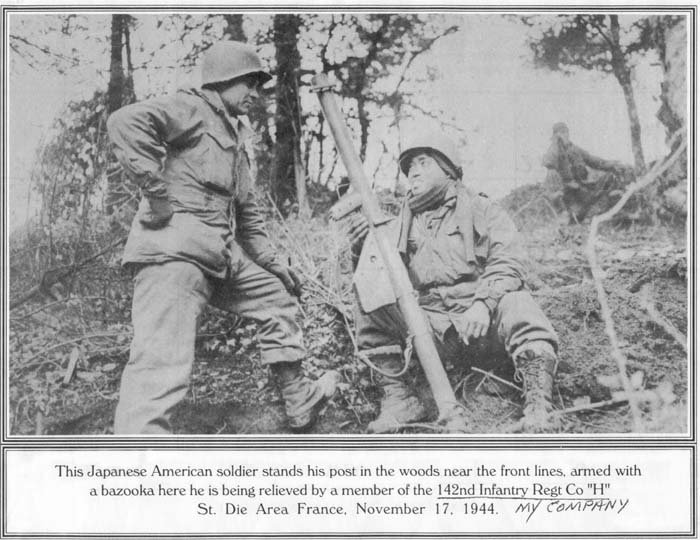
Our own artillery started coming in over our heads and striking where the
Seigfried line was. We could see several places where the bombardments were
striking. This continued for quite a long time. There didn’t seem to be much
German artillery in our area. When our ground troops made it to the line,
most of the Germans were gone. In this area we had captured a part of Germany.
The Germans retreated along Hitler’s Autobahn in a southward direction. This
made wonderful traveling for our 36th division. However, the Germans destroyed
the bridges and this slowed down the chase.
At one point in our southern travel we reached a place in the Autobahn with
strange lines. We were going through a forest.
In that forest area were three fighter airplanes, each in its own cleared spot
which had paths leading to the Autobahn. The Autobahn at that point was a
straight line which went completely out of sight. The fighters were jet
propelled. At that time, none of the other countries had jet propelled
fighters. One thing was clear - they all had swastikas.
Our convoy continued traveling down the Autobahn. Thank goodness those
airplanes were grounded.
Our convoy was able to travel fast. There wasn’t any opposition from the
German troops. When we began to run out of gasoline, food, etc., we stopped
and took time to stock up. The supplies followed us in trucks.
We started our trip with the goal being the Austrian border.
When we reached a point south of Munich our 36th division captured two of the
highest-ranking generals, Hermann Georging and Field Marshall Gerd Von
Rundstedt. Four other lesser generals were captured. It’s obvious that the
war had ended.
This will be the final memory. It happened a short time before VE Day. The
36th division that I was a part of was in the area near Munich. We were in a
convoy traveling southward. We came to an area, very large and vacant for
miles around. The road that we were on did lead us into a group of buildings.
The largest building had some windows, two places that must have been doors.
There was a large yard big enough to contain a lot of people. The yard had a
wire fencing about ten feet high, with only one exit.
The only human life that we saw were three old men, dressed in robes, striped,
and dirty. They had beards and slippers of some kind on their feet. They were
begging for food. American soldiers always had some rations they could share.
There were two other buildings across a yard. The first one had a walkway from
it to the second building. We didn’t see the inside of any of these buildings.
We decided that second building was a bathhouse. The third building had a huge
smoke pipe coming out the roof.
There is one more thing. A few more yards down the yard, a railroad track came
in there. There was a flatbed railroad car loaded with what I thought to be
stacked logs.
We were three soldiers searching around the yard. The more we looked at the
“logs” we suspected that it was something else. We moved closer. It was human
bodies - they had been stripped of their clothing and stacked on the railroad
car. There was no doubt about what the big building with the huge smoke stack
was used for. It was a gas chamber.
Our convoy had to go south. Everything was quiet. We took off the following
morning and by night time we had reached the border of Austria. We were in the
mountains and all we had around us was the beauty of the mountains and valleys.
I think it was kind of like being in heaven.
In a couple of days, we were traveling north again. It was announced that the
36th division would be a part of the Army of Occupation. This was a shock to
me because I thought that I would be one of the first to go home. I found out
later that each soldier would be judged according to his experience. My
experience included four major campaigns and the invasion by amphibious landing
in southern France - also, the Bronze Star Medal for meritorious service in
frontline combat.
Getting ready to go home becomes a complicated event. The group that I was
with shipped out to a headquarters where we were processed. It took about a
month. They loaded us onto a train that took us right down through the center
of France. It so happened that this is very close to the battle ground that we
fought our way up France. We arrived at Marseille and boarded a ship. It is
quite a long trip on the Mediterranean before Gibraltar is reached. This part
of the trip was beautiful, the water was like a big pond, the weather was warm
and smooth. When we reached Gibraltar we could see far out into the Atlantic
Ocean. It didn’t look too smooth, as a matter of fact, it looked rough. It
wasn’t long before sea sickness began to appear. That included me. I think
that we were sick about three to four days. The rest of the trip went along
smoothly. We were told that we would be able to see the Statue of Liberty in a
distance. We did see it. Everybody was proud and happy.
We went through another processing and it didn’t take too long before we
arrived at Albany railroad station. My wife Jean and her father met me and we
drove to Greenwich. The next day I saw my son David, he was three years old.
As years went by, Carol Elizabeth and Paul William were born.
Conclusion
As I write this final piece, I see the calendar before me. On November 11,
2000 another Veteran’s Day will be celebrated. I am 81 years old now and I
think my memory of World War II is better than what happened on Election Day.
There are always a few old veterans that play a part in the ceremony on
Veteran’s Day. Quite often as they stand at attention, saluting the ceremony,
tears will be running down their cheeks.
I would like to enter one more story about what can happen to a friend. My
friend was from Florida. We were in the same squad. He was a quiet easygoing
friend.
The squad was pulled back along with the company. This happened occasionally.
The sergeant called to me, “Jackson, you go down and help the kitchen serve the
meals.” I was on K.P. for three days. On the third day at supper time my
friend “Whitee” came through the chow line. The pots were lined up and we
dished out a large spoon full to each person. Whitee said, “Aren’t you coming
up tonight, Jack?” I made a smart answer like, “No I can’t do it tonight -
I’ve got a lot of dishes to clean.”
What I said brought about a big laugh. The platoon moved out that night. On
the next day, the kitchen withdrew and I got ready to follow the platoon.
There were a couple of other soldiers returning also. When the jeep let us
out, we hiked into the H Co. - 142 headquarters. They got us to the squads
that we belonged to. It was then that I found out that Whitee had been
killed in the line of duty.
I wasn’t wounded at all during start to finish. Any combat soldier that can
make that statement should appreciate his blessing. I do.
End of story.
Isaac Jackson







